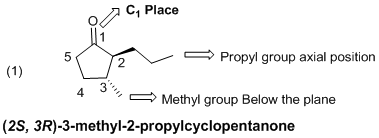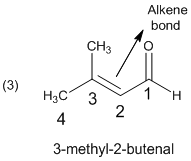
(a)
Interpretation:
The systematic (IUPAC) name of each group substituent in the given organic molecules should be draw and identified.
Concept introduction:
The several organic compounds can be named by using certain rules given by IUPAC (International Union for Pure and applied chemistry).
The IUPAC name consists of three parts in major namely Prefix, suffix and root word.
Prefix: Represents the substituent present in the molecule and its position in the root name.
For example the saturated hydrocarbons not only from only carbon-hydrogen bonds rather than the carbon-carbon bonds that have added hydrogen atoms. These
Suffix: Denotes the presence of functional group if any in the molecule. It can be an alkane,
Root word: It represents the longest continuous carbon skeleton of the organic molecule.
To identify: The systematic (stereo chemical) name for the given molecule (a).
(a)
Explanation of Solution
Explanation

The given molecule (a) is drawn as above, in the case the carbonyl group is part of carbonyl group of a five membered ring, so the given molecule is cyclopentane-1-one. In the given molecule the parent carbon skeleton is cyclic in nature which contains of 5 carbons one keto group (-C=O). Hence root name of the molecule is ‘cyclopentane-1-one’. Since it is an alkane with five carbons, one keto then ‘1-pentanone’ will be the functional carbon chain name.
Further the molecule (a) one cyclic
Hence the systematic name for the molecule (a) is (2S, 3R)-3-methyl-2-propylcyclopentanone.
(b)
Interpretation:
The systematic (IUPAC) name of each group substituent in the given organic molecules should be draw and identified.
Concept introduction:
The several organic compounds can be named by using certain rules given by IUPAC (International Union for Pure and applied chemistry).
The IUPAC name consists of three parts in major namely Prefix, suffix and root word.
Prefix: Represents the substituent present in the molecule and its position in the root name.
For example the saturated hydrocarbons not only from only carbon-hydrogen bonds rather than the carbon-carbon bonds that have added hydrogen atoms. These alkanes have to prefix ‘cyclo’ due to the configuration of rings of carbon atoms.
Suffix: Denotes the presence of functional group if any in the molecule. It can be an alkane, alkene, alkyne, alcohol, carboxylic acid, alcohol etc. For example alkene molecules, suffix will be ‘ene’. (Or) If the presence of completely saturated alkane molecules, suffix will be ‘ane’.
Root word: It represents the longest continuous carbon skeleton of the organic molecule.
To identify: The systematic (stereo chemical) name for the given molecule (a).
(b)
Explanation of Solution
Explanation

The given molecule (b) is drawn; the parent carbon skeleton is cyclic nature which contains 6 carbons one keto group. Hence root name of the molecule is cyclohexane-1-carbaldehyde. Here given compound with six carbon atoms, one keto groups then cyclohexane
The cyclic compound containing a one aldehyde (
Hence the systematic name for the molecule (b) is ‘Cyclohexane-1-aldehyde’ (aldehyde group is connected to a six membered ring at C1 place).
(c)
Interpretation:
The systematic (IUPAC) name of each group substituent in the given organic molecules should be draw and identified.
Concept introduction:
The several organic compounds can be named by using certain rules given by IUPAC (International Union for Pure and applied chemistry).
The IUPAC name consists of three parts in major namely Prefix, suffix and root word.
Prefix: Represents the substituent present in the molecule and its position in the root name.
For example the saturated hydrocarbons not only from only carbon-hydrogen bonds rather than the carbon-carbon bonds that have added hydrogen atoms. These alkanes have to prefix ‘cyclo’ due to the configuration of rings of carbon atoms.
Suffix: Denotes the presence of functional group if any in the molecule. It can be an alkane, alkene, alkyne, alcohol, carboxylic acid, alcohol etc. For example alkene molecules, suffix will be ‘ene’. (Or) If the presence of completely saturated alkane molecules, suffix will be ‘ane’.
Root word: It represents the longest continuous carbon skeleton of the organic molecule.
To identify: The systematic (stereo chemical) name for the given molecule (a).
(c)
Explanation of Solution
Explanation

The given molecule is drawn as shown above. This compound (c) is an one aldehyde group with a parent of four carbon, so the parent should be butanol. In the given molecule the parent carbon skeleton is contains 4 carbons one double bond, which indicated by changing ‘an’ to ‘en’ as in propane into propene.
In molecule (c) parent (or) functional group is numbered so that the
Hence the systematic name for the molecule (c) is 3-methyl-2-butenal.
(d)
Interpretation:
The systematic (IUPAC) name of each group substituent in the given organic molecules should be draw and identified.
Concept introduction:
The several organic compounds can be named by using certain rules given by IUPAC (International Union for Pure and applied chemistry).
The IUPAC name consists of three parts in major namely Prefix, suffix and root word.
Prefix: Represents the substituent present in the molecule and its position in the root name.
For example the saturated hydrocarbons not only from only carbon-hydrogen bonds rather than the carbon-carbon bonds that have added hydrogen atoms. These alkanes have to prefix ‘cyclo’ due to the configuration of rings of carbon atoms.
Suffix: Denotes the presence of functional group if any in the molecule. It can be an alkane, alkene, alkyne, alcohol, carboxylic acid, alcohol etc. For example alkene molecules, suffix will be ‘ene’. (Or) If the presence of completely saturated alkane molecules, suffix will be ‘ane’.
Root word: It represents the longest continuous carbon skeleton of the organic molecule.
To identify: The systematic (stereo chemical) name for the given molecule (a).
(d)
Explanation of Solution
Explanation

The given linear molecule is drawn as shown above. The parent is a chain of six carbon atoms, with the carbonyl group at C3, so the parent is 3-hexanone. Further the identified number of substituents, above the compound is only one methyl group at C4 position.
Hence the assign a configuration to the chirality center for the molecule (d) is (S)-4-methyl-3-hexanone.
Want to see more full solutions like this?
Chapter 19 Solutions
ORGANIC CHEMISTRY..LL W/SM, SG,SM ACCES
 ChemistryChemistryISBN:9781305957404Author:Steven S. Zumdahl, Susan A. Zumdahl, Donald J. DeCostePublisher:Cengage Learning
ChemistryChemistryISBN:9781305957404Author:Steven S. Zumdahl, Susan A. Zumdahl, Donald J. DeCostePublisher:Cengage Learning ChemistryChemistryISBN:9781259911156Author:Raymond Chang Dr., Jason Overby ProfessorPublisher:McGraw-Hill Education
ChemistryChemistryISBN:9781259911156Author:Raymond Chang Dr., Jason Overby ProfessorPublisher:McGraw-Hill Education Principles of Instrumental AnalysisChemistryISBN:9781305577213Author:Douglas A. Skoog, F. James Holler, Stanley R. CrouchPublisher:Cengage Learning
Principles of Instrumental AnalysisChemistryISBN:9781305577213Author:Douglas A. Skoog, F. James Holler, Stanley R. CrouchPublisher:Cengage Learning Organic ChemistryChemistryISBN:9780078021558Author:Janice Gorzynski Smith Dr.Publisher:McGraw-Hill Education
Organic ChemistryChemistryISBN:9780078021558Author:Janice Gorzynski Smith Dr.Publisher:McGraw-Hill Education Chemistry: Principles and ReactionsChemistryISBN:9781305079373Author:William L. Masterton, Cecile N. HurleyPublisher:Cengage Learning
Chemistry: Principles and ReactionsChemistryISBN:9781305079373Author:William L. Masterton, Cecile N. HurleyPublisher:Cengage Learning Elementary Principles of Chemical Processes, Bind...ChemistryISBN:9781118431221Author:Richard M. Felder, Ronald W. Rousseau, Lisa G. BullardPublisher:WILEY
Elementary Principles of Chemical Processes, Bind...ChemistryISBN:9781118431221Author:Richard M. Felder, Ronald W. Rousseau, Lisa G. BullardPublisher:WILEY





